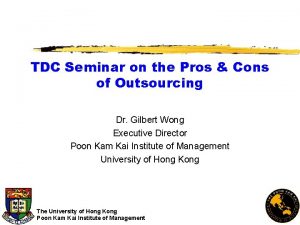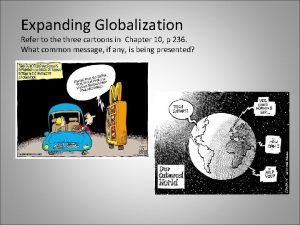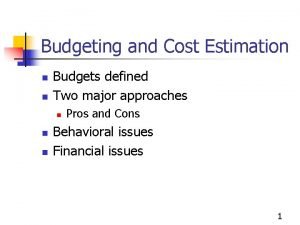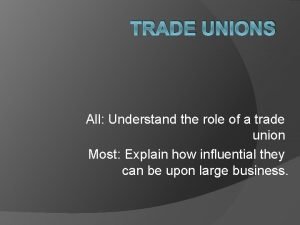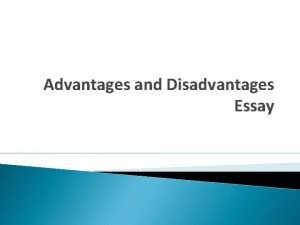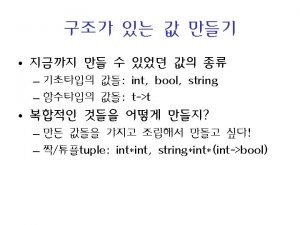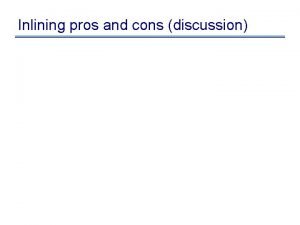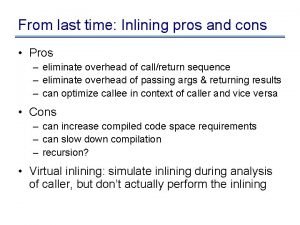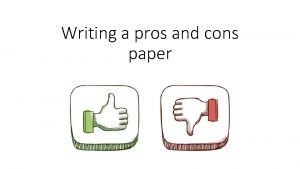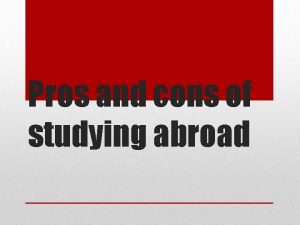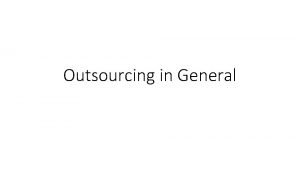TDC Seminar on the Pros Cons of Outsourcing













- Slides: 13

TDC Seminar on the Pros & Cons of Outsourcing Dr. Gilbert Wong Executive Director Poon Kam Kai Institute of Management University of Hong Kong The University of Hong Kong Poon Kam Kai Institute of Management

Reasons for outsourcing z Examples of outsourcing y A credit card company outsource it data capture and customers expenditure reporting IT function y A hotel outsource its laundry services y The university outsource its catering service z Reasons y ‘Contain’ cost because of the lack of ‘competence’ & sharing the vendor’ economies of scale y Avoid specific investments y Improve service y Refocus resource strategically HKU-PKKI

The context for outsourcing z Intensified competition leading to y y Need for building distinctive competence Organizational downsizing Need for flexibility The need for diverse inputs in businesses in the ‘new economy’ e. g. delivery health care service on the net z But are these ‘alliances/partnering’ or ‘outsourcing’? HKU-PKKI

Why ‘in-sourcing’ in the first place? z Theory of the ‘firm’ as resource coordinator – but why not the ‘market’ e. g why do hotels have an ‘Engineering’ department? z Transaction cost theory – organizations ‘in-source’ to minimize transaction cost arising out of: y Uncertainty in the demand y Possible ‘opportunistic’ behavior of supplier y The cost of writing a detailed contract and the cost of enforcing the contract z Developing the distinctive competence of the organization – in specific activities e. g. software development or the coordination of activities e. g. sales and IT team z >> what to ‘outsource’ and the nature of the ‘outsourcing’ relationships HKU-PKKI

What to outsource? Two dimensions: x x Useful vs. critical function Commodity vs. differentiator z Useful commodity - activities that do not distinguish the company from its competitors e. g. payroll, accounting system - outsource z Critical commodity - activities that are important but does not ‘differentiate’ e. g. aircraft maintenance – outsource or in-source depending on strategy z Useful differentiator - differentiate the company but not in a critical way – good IT team developing special application outside the company’s main business – migrate or integrate z Critical differentiator e. g. research in an investment bank – keep in house HKU-PKKI

What to outsource? Critical Useful Internal or External provider Commodity Internal provider Migrate or integrate Differentiate HKU-PKKI

The transition to outsourcing z Contractual issues y how to draft the contracts y who should be involved, transition process z People issues y What will happen to existing staff, y how the ‘insiders’ relate to the ‘outsider’ z Organizational adjustment HKU-PKKI

Types of inter-firm relationships HKU-PKKI

From outsourcing to partnering z From outsourcing contracts on a one-off basis to relationship management z From exchange of interest to mutual learning z From hard to hard AND soft benefits z From close ended to open ended relationships z From legalist rights to honor & obligations z From having control to sharing control z From ‘contractual deliveries’ to organizational adjustments z From dealing at the strategic level to partnering at all levels ¤ Its all about managing a network of relationships HKU-PKKI

Dimensions of a successful outsourcing relationship z Relationship structure y where the parties define the goals of the relationship – What they hope to accomplish, and most importantly, how they will measure success z The management structure y defines how both organizations will work together to ensure success and, when necessary, take corrective actions on lessthan-desired outcomes z Ref: www. firmbuilder. com HKU-PKKI

Relationship structure 1. Define relationship strategically – creating a basis for LT cooperation 2. Capturing the intent, not just the terms of the relationship 3. Manage expectation carefully – chances of repeated business? 4. Defined scorecard 5. Differentiate between the client and the Customers 6. Match pricing & contractual terms to the goals and culture of the partners 7. Create incentives for improvements 8. Define management structure in advance HKU-PKKI

Management structure 1. Keep strategic responsibilities close to the top, but create multilevel organizational links 2. Conduct regular goal oriented meetings 3. Encourage lateral, multi-channel communications 4. Define escalation process 5. Use scorecard to keep track of performance 6. Reward providers employees 7. Implement a change process 8. Treat the relationship as a valuable organizational asset HKU-PKKI

HKU-PKKI
 Tdc seminar
Tdc seminar Conswater
Conswater Maquiladoras pros and cons
Maquiladoras pros and cons Disadvantages of gagne's instructional events
Disadvantages of gagne's instructional events Personal health budgets pros and cons
Personal health budgets pros and cons Eco holiday ielts speaking
Eco holiday ielts speaking Trade union pros and cons
Trade union pros and cons Pros and cons of robber barons
Pros and cons of robber barons Disadvantages of greenhouse farming
Disadvantages of greenhouse farming Advantages and disadvantages essay structure
Advantages and disadvantages essay structure Experiments on animals pros and cons
Experiments on animals pros and cons Pros and cons of tableau
Pros and cons of tableau Objective and task method pros and cons
Objective and task method pros and cons Edible vaccines pros and cons
Edible vaccines pros and cons
